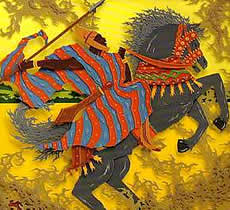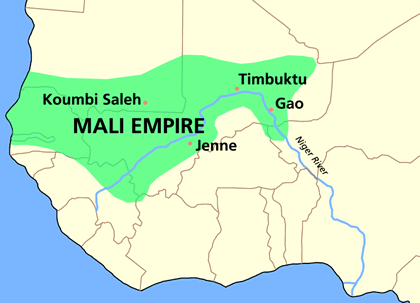World History
Sundiata is remembered as the first of the kings of Mali. A mythic figure in West African history, he is known as the Lion King. He was born to a Mandingo chief, Nara Fe Maghan, and his second wife, Sogolon.
After the death of his father, he and his mother had to flee because his 11 other brothers were jealous of the love his father had shown him and were a threat to his life.
The death of Nara Fe Maghan came at a bad time for the Malinke people, for at this time Sumanguru was trying to revive the kingdom of Ghana. Sumanguru killed Sundiata’s 11 brothers but either did not find Sundiata or dismissed him as a threat because the boy was lame.
Sundiata gradually built up his own state of Kangaba, without attracting much notice from his father’s killer. In 1235 Sundiata challenged Sumanguru at Kirina, in a largely cavalry battle, with both armies mounted on horses and camels.
The warriors would have worn heavily padded cloth coats of armor, although perhaps the more wealthy ones like Sundiata would have had chain mail and helmets imported from North Africa by the Arabs.
Sundiata won by a decisive cavalry charge, which left Sumanguru dead, either killed in the fighting or executed after. With the death of Sumanguru, Sundiata became the mansa, or chief, of a federation in western Niger, with his new capital at Niani. Sundiata carefully organized his new realm.
According to Ancient African Civilizations, Sundiata’s “division of the world assigned specific occupations—warrior, ironsmith, djeli (storyteller), and so on—to designated kin groups, reserving the office of mansa for Sundiata’s own dynasty, that of the Keita.
Sundiata also set up an administrative system based on provinces, which accommodated regional desires for a degree of self-government while allowing the mansa to retain ultimate control over what was fast becoming the empire of Mali.â€
Sundiata himself converted to Islam but did not compel his people to become Muslims. His conversion was a pragmatic act of statecraft, in order to gain a better position with the Arabs, who held much of the trade of western Africa, as they would until the coming of the Europeans in the 15th century with the advent of the Portuguese.
Following the death of Sundiata, the kingdom that would be known as Mali continued to expand during the reign of his son Uli (1250–70). There was a period of strife when a general named Sakura seized power. Sakura decided to fulfill the Islamic vow of the hajj and make a pilgrimage from Mali to Mecca.
On the return journey he died, and power reverted to the family of Sundiata, and “the title of mansa returned to the Keita family, passing in 1307 to Kankan Musa, a son of Sundiata’s brother Manding Bory.â€
Under Kankan Musa, also known as Mansa Musa, Mali reached its apex. Kankan Musa (reigned 1307–37) also made the hajj, the pilgrimage to Mecca, in 1324 and returned safely. But with him on his return, Kankan also brought Islamic scholars from Mecca.
With them he established centers of learning in Timbuktu, Jenne (or Djenne), and Gao. A huge mud brick mosque in Jenne would later be restored in 1907, when Moulay Hafid ruled as sultan of Morocco.
Ibn Batuta, the great Arab traveler, came to Mansa Musa’s kingdom on his tour of Islamic Africa. Mansa Musa also introduced Islamic architecture to West Africa with the arrival of Ishak as-Sahili, who built a series of mosques.
His development of Mali was made possible by the great wealth in gold at his disposal. According to Joseph E. Harris in Africans and Their History, a European atlas would chronicle that “this Negro Lord is called Mansa Musa, Lord of the Negros of Guinea.
So abundant is the gold which is found in his country that he is the richest and most noble king in all the land.†Under Mansa Musa, the kingdom of Mali, the creation of Sundiata, enjoyed—in all senses of the word—a true golden age.
- Sunni Ali - Founder Of West African Songhai Dynasty
Sunni Ali Sunni Ali was an African ruler who founded the Songhai Empire in the 15th century. He was the hereditary ruler of the kingdom of Songhai, which existed from the 11th century and was centered in the city of Gao on the Niger River in the southeastern...
- History Of Mali
History of Mali. This is a brief history of the African nation of Mali. Much of essay deals with more recent political activity. The Encyclopædia Britannica notes, "Officially Republic of Mali, French République du Mali, landlocked state in central...
- Mr. Dowling's African History Page
Mr. Dowling's African History Page. This is a nice history site designed for children and teenagers. Of course, some adults may find it useful too! It gives brief background information on the ancient civilizations and cities of ancient Africa including...
- Mud Mosques Of Mali
Mud Mosques of Mali - A photographic survey of 515 mosques of the Niger Inner Delta, an area which played a significant role in the early expansion of Islam into West Africa. The photographs are in alphabetical order by location and include thumbnails...
- Mansa Musa: Richest Man Ever
That's a picture of Mansa Musa, the empeor of Mali in the 14th century. He is the richest man in the world, "after adjusting for inflation," according to this article in the Huffington Post. He was worth over 400 billion, making him richer than Bill...
World History
Sundiata - King of Mali
 |
| Sundiata - King of Mali |
After the death of his father, he and his mother had to flee because his 11 other brothers were jealous of the love his father had shown him and were a threat to his life.
The death of Nara Fe Maghan came at a bad time for the Malinke people, for at this time Sumanguru was trying to revive the kingdom of Ghana. Sumanguru killed Sundiata’s 11 brothers but either did not find Sundiata or dismissed him as a threat because the boy was lame.
Sundiata gradually built up his own state of Kangaba, without attracting much notice from his father’s killer. In 1235 Sundiata challenged Sumanguru at Kirina, in a largely cavalry battle, with both armies mounted on horses and camels.
  |   |
The warriors would have worn heavily padded cloth coats of armor, although perhaps the more wealthy ones like Sundiata would have had chain mail and helmets imported from North Africa by the Arabs.
Sundiata won by a decisive cavalry charge, which left Sumanguru dead, either killed in the fighting or executed after. With the death of Sumanguru, Sundiata became the mansa, or chief, of a federation in western Niger, with his new capital at Niani. Sundiata carefully organized his new realm.
According to Ancient African Civilizations, Sundiata’s “division of the world assigned specific occupations—warrior, ironsmith, djeli (storyteller), and so on—to designated kin groups, reserving the office of mansa for Sundiata’s own dynasty, that of the Keita.
 |
| Mali empire map |
Sundiata also set up an administrative system based on provinces, which accommodated regional desires for a degree of self-government while allowing the mansa to retain ultimate control over what was fast becoming the empire of Mali.â€
Sundiata himself converted to Islam but did not compel his people to become Muslims. His conversion was a pragmatic act of statecraft, in order to gain a better position with the Arabs, who held much of the trade of western Africa, as they would until the coming of the Europeans in the 15th century with the advent of the Portuguese.
Following the death of Sundiata, the kingdom that would be known as Mali continued to expand during the reign of his son Uli (1250–70). There was a period of strife when a general named Sakura seized power. Sakura decided to fulfill the Islamic vow of the hajj and make a pilgrimage from Mali to Mecca.
On the return journey he died, and power reverted to the family of Sundiata, and “the title of mansa returned to the Keita family, passing in 1307 to Kankan Musa, a son of Sundiata’s brother Manding Bory.â€
Under Kankan Musa, also known as Mansa Musa, Mali reached its apex. Kankan Musa (reigned 1307–37) also made the hajj, the pilgrimage to Mecca, in 1324 and returned safely. But with him on his return, Kankan also brought Islamic scholars from Mecca.
With them he established centers of learning in Timbuktu, Jenne (or Djenne), and Gao. A huge mud brick mosque in Jenne would later be restored in 1907, when Moulay Hafid ruled as sultan of Morocco.
Ibn Batuta, the great Arab traveler, came to Mansa Musa’s kingdom on his tour of Islamic Africa. Mansa Musa also introduced Islamic architecture to West Africa with the arrival of Ishak as-Sahili, who built a series of mosques.
His development of Mali was made possible by the great wealth in gold at his disposal. According to Joseph E. Harris in Africans and Their History, a European atlas would chronicle that “this Negro Lord is called Mansa Musa, Lord of the Negros of Guinea.
So abundant is the gold which is found in his country that he is the richest and most noble king in all the land.†Under Mansa Musa, the kingdom of Mali, the creation of Sundiata, enjoyed—in all senses of the word—a true golden age.
- Sunni Ali - Founder Of West African Songhai Dynasty
Sunni Ali Sunni Ali was an African ruler who founded the Songhai Empire in the 15th century. He was the hereditary ruler of the kingdom of Songhai, which existed from the 11th century and was centered in the city of Gao on the Niger River in the southeastern...
- History Of Mali
History of Mali. This is a brief history of the African nation of Mali. Much of essay deals with more recent political activity. The Encyclopædia Britannica notes, "Officially Republic of Mali, French République du Mali, landlocked state in central...
- Mr. Dowling's African History Page
Mr. Dowling's African History Page. This is a nice history site designed for children and teenagers. Of course, some adults may find it useful too! It gives brief background information on the ancient civilizations and cities of ancient Africa including...
- Mud Mosques Of Mali
Mud Mosques of Mali - A photographic survey of 515 mosques of the Niger Inner Delta, an area which played a significant role in the early expansion of Islam into West Africa. The photographs are in alphabetical order by location and include thumbnails...
- Mansa Musa: Richest Man Ever
That's a picture of Mansa Musa, the empeor of Mali in the 14th century. He is the richest man in the world, "after adjusting for inflation," according to this article in the Huffington Post. He was worth over 400 billion, making him richer than Bill...
